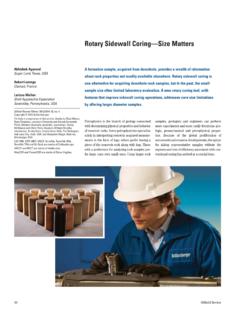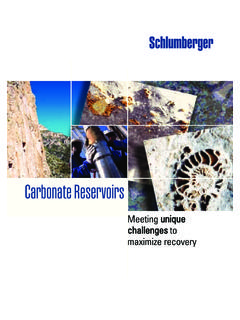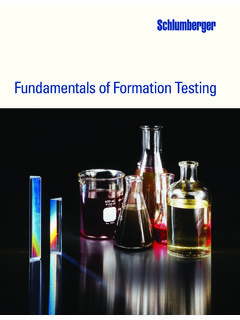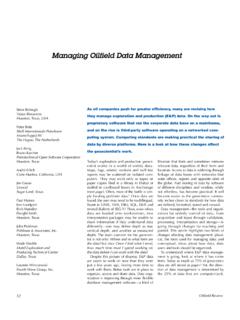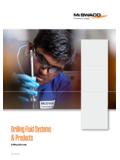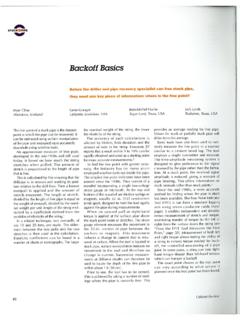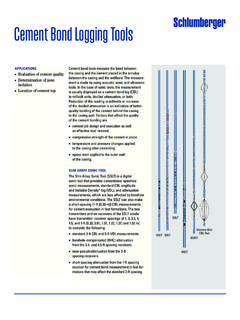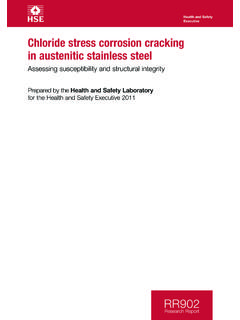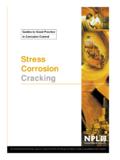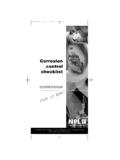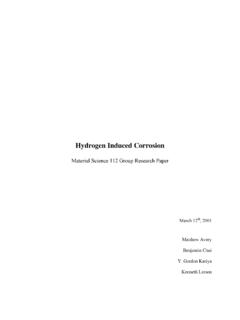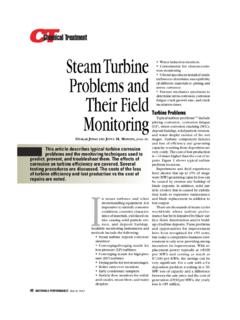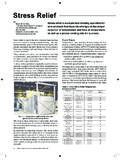Transcription of Corrosion in the Oil Industry - Schlumberger
1 Corrosion costs US industries alone an esti-mated $170 billion a year. The oil Industry ,with its complex and demanding produc-tion techniques, and the environmentalthreat should components fail, takes anabove average share of these the deterioration of a metal orits properties attacks every component atevery stage in the life of every oil and gasfield. From casing strings to production plat-forms, from drilling through to abandon-ment, Corrosion is an adversary worthy ofall the high technology and research we canthrow at it. Oxygen, which plays such an importantrole in Corrosion , is not normally present inproducing formations. It is only at thedrilling stage that oxygen-contaminated flu-ids are first introduced. Drilling muds, leftuntreated, will corrode not only well casing,but also drilling equipment, pipelines andmud handling equipment.
2 Water and car-bon dioxide produced or injected for sec-ondary recovery can cause severe corro-sion of completion strings. Acid used toreduce formation damage around the wellor to remove scale readily attacks and surface pipelines can beeroded away by high production velocities4 Oilfield ReviewMost metals exist in nature as stable ores of oxides, carbonates or sulfides. Refining them, to make themuseful, requires energy. Corrosion is simply nature s way of reversing an unnatural process back to a lowerenergy state. Preventing Corrosion is vital in every step in the production of oil and in the Oil IndustryDenis BrondelMontrouge, FranceRandy EdwardsColumbus, Ohio, USAA ndrew HaymanClamart, FranceDonald HillTulsa, Oklahoma, USAS hreekant MehtaSt. Austell, EnglandTony SemeradMobilSumatra, Indonesiaor blasted by formation sand.
3 Hydrogen sul-fide [H2S] poses other problems (next page).Handling all these Corrosion situations, withthe added complications of high tempera-tures, pressures and stresses involved indrilling or production, requires the expertiseof a Corrosion engineer, an increasingly keyfigure in the it is almost impossible to preventcorrosion, it is becoming more apparent thatcontrolling the Corrosion rate may be themost economical solution. Corrosion engi-neers are therefore increasingly involved inestimating the cost of their solutions to cor-rosion prevention and estimating the usefullife of equipment. For example, develop-ment wells in Mobil s Arun gas field inIndonesia have been monitored for corro-sion since they were drilled in wells were completed using7-in. L-80 grade carbon steel tubing anH2S-resistant steel allowing flow rates inexcess of 50 MMscf/D [ MMscm/D] atover 300 F [150 C].
4 High flow rates, H2 Sand carbon dioxide [CO2] all contributedto the Corrosion of the tubing. Laboratoryexperiments simulated the Arun well con-ditions, alongside continued field monitor-ing. These help find the most economicalsolution to the Corrosion showed that the carbon steel tubingwould have to be changed to more expen-sive chromium steel or to Corrosion -resis-tant alloy (CRA).For help in preparation of this article, thanks to DylanDavies, Schlumberger Cambridge Research, AhmadMadjidi, Schlumberger GeoQuest, Abu Dhabi, UAE;Nabil Mazzawi, Schlumberger Wireline & Testing,Tripoli, Libya; Perry Nice, Statoil, Stavanger, Norway;Barry Nicholson, Schlumberger Wireline & Testing,Jakarta, Indonesia; Daniel Roche, Elf, Bergen, Norway;Philippe Rutman and Derek Stark, Schlumberger Wire-line & Testing, Montrouge, France; Dave Thompson, Schlumberger Wireline & Testing, Bergen, Norway.
5 AndPiers Temple, Joe Vinet and Mohamed Watfa, Schlum-berger Wireline & Testing, Abu Dhabi, (Cement Evaluation Tool), CORBAN, CPET (Corro-sion and Protection Evaluation Tool), FACT (Flux ArrayCorrosion Tool), IDCIDE, IDFILM, IDSCAV, METT (Mul-tifrequency Electromagnetic Thickness Tool), PAL (PipeAnalysis Log), UBI (Ultrasonic Borehole Imager) andUSI (UltraSonic Imager) are marks of Sutanto H, Semerad VAW and Bordelon TP: Simula-tion of Future Wellbore Corrosion With Low Produc-tion Rate Field Tests, paper 571, presented at the Cor-rosion 91 NACE Annual Conference and CorrosionShow, Cincinnati, Ohio, USA, March 11-15, VAW and Sutanto H: Wellbore CorrosionLogging of Deep Hot Corrosive Wells, paper OSEA90141, presented at the 8th Offshore South East AsiaConference, Singapore, December 4-7, AI, Prouheze JC and Petersen GJ: Corro-sion-Resistant Alloys for Hot, Deep, Sour Wells: Prop-erties and Experience, SPE Production Engineering6,no.
6 4 (November 1991): MASZ and Holland S: Corrosion -ResistantTubulars for Prolonging GWI Well Life, paper SPE21365, presented at the SPE Middle East Oil Show,Manama, Bahrain, November 16-19, 1994nCorrosion in everyaspect of the oilindustry. From gen-eralized corrosioncaused by oxygen-rich environmentson marine struc-tures to sulfidestress Corrosion inhostile wells, thecorrosion engineeris faced with awhole gamut ofproblems. The Basic Corrosion CellBy recognizing Corrosion when it doesoccur, and by understanding the mecha-nisms involved, Corrosion engineers maybegin to eliminate Corrosion by basic galvanic Corrosion mechanismfollows the principle of a battery. A typicalbattery requires two dissimilar metals con-nected together and immersed in an elec-1. For a comprehensive reference book see:ASM Handbook Volume 13 Park,Ohio, USA: ASM International, an easier read:Jones LW: Corrosion and Water Technology forPetroleum Producers.
7 Tulsa, Oklahoma, USA: OGCIP ublications, RN: Corrosion in Oil and Gas Production, Journal of Petroleum Technology39 (July 1987): protectionStressStressOxygen-rich seawater Meteoric oxygen-rich waterCO2, H2S, water, bacteriaCrustaceansCementMud inhibitors, scavengersWater injection, oxygen scavengersAcidizingPipeline coatingSacrificialanodesInhibitorsUnsupp ortedcasing stressScaleIdentifying the Causes and Applying ControlsThere are many sources of Corrosion andmany more methods of slowing the processdown. This section looks at different partsof the Industry and identifies typical corro-sion problems and some of the solutions(next page).Offshore structures On surface equip-ment, the simplest solution is to place aninsulating barrier over the metal installations are often painted withzinc-rich primers to form a barrier againstrain, condensation, sea mist and spray.
8 Thezinc primer not only forms a physical bar-rier, but also acts as a sacrificial anodeshould the barrier be structures are also protected inother zone above the high tidemark, called the splash zone, is constantlyin and out of water. The most severe corro-sion occurs here. Any protective coating orfilm is continually eroded by waves andthere is an ample supply of oxygen andwater. Common methods of controlling cor-rosion in this zone include further coatingand also increasing metal thickness to com-pensate for higher metal part of the structure in the tidal zone issubjected to less severe Corrosion than thesplash zone and can benefit from cathodicprotection systems at high works by forcing anodic areas tobecome cathodes. To achieve this, a reversecurrent is applied to counteract the corrosioncurrent.
9 The current can be generated by anexternal DC source impressed cathodicprotection or by using sacrificial rest of the structure exposed to lesssevere seawater Corrosion is protected bycathodic protection. However, crustaceansand seaweed attach to the submerged partsadding weight that may increase stress-related Corrosion . This mechanism occurswhen the combined effects of crevice, orpitting, Corrosion and stress propagatecracks leading to structural failure. How-ever, a covering of life does restrict oxygenreaching metal, and so reduces forms of structural stress are alsoimportant. Low-frequency cyclic stress resulting from factors such as waves, tidesand operating loads can allow time forcorrosion within cracks as they are and accounting for these stressesare therefore an extremely important part ofcorrosion (below).
10 3 All metals have a tendencyto dissolve or corrode to a greater or lesserdegree. In this case, the metal with thegreater tendency to corrode forms the nega-tive pole and is called the two are connected, the other metalforms the positive pole, or of positive metal ions from the anodecauses a release of free electrons. This pro-cess is called oxidation. The buildup ofelectrons generates an electrical potential,causing them to flow through the conductorto the cathode. At the cathode, excess elec-trons are neutralized or taken up by ions inthe electrolyte. This process is called reduc-tion. As long as reduction reactions predom-inate, no metal is lost at the cathode. Theanode will continue to corrode as long asthe electric circuit is maintained and themetal ions are removed from solution bycombining with other elements to make upcorrosion and cathodes can form on a sin-gle piece of metal made up of small crystalsof slightly different compositions.
